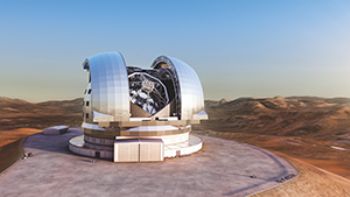
UK researchers have signed an agreement that will see them lead the development of one of the first instruments for what will become the world’s largest visible-light and infra-red telescope — the European Extremely Large Telescope (E-ELT). The spectrograph — called Harmoni and being developed by University of Oxford (
www.ox.ac.uk) and STFC’s UK Astronomy Technology Centre (
www.ukatc.stfc.ac.uk/UKATC) — will give the European Southern Observatory (ESO)’s telescope a sensitivity that is hundreds of times better than any current telescope of its kind.
Located on top of Cerro Armazones in the Atacama Desert in northern Chile, the E-ELT will have a giant main mirror some 39m in diameter. This project is one of the biggest global science collaborations in history and includes an £88 million investment by the UK Government. UK industry has already won over £10 million worth of contracts from the E-ELT in advance of Harmoni, and that figure is expected to at least match the Government’s investment by the time construction is complete.
The Harmoni instrument will observe an astronomical object in three dimensions simultaneously, with spatial information in two dimensions and wavelength in the third. The Harmoni project is being led by Professor Niranjan Thatte from the University of Oxford in collaboration with the Science and Technology Facilities Councils’s UK Astronomy Technology Centre, Edinburgh.
“Harmoni has been designed to be a workhorse instrument that will be used by all the early science being carried out at the E-ELT. That’s why we designed it to be easy to calibrate and operate, giving the E-ELT a ‘point and shoot’ spectroscopic capability.
“It will revolutionise observational astronomy through the 2020s and beyond. By studying the light from galaxies — distant and nearby — in great detail, we hope to unravel the physical processes that have shaped the cosmos throughout its history.”